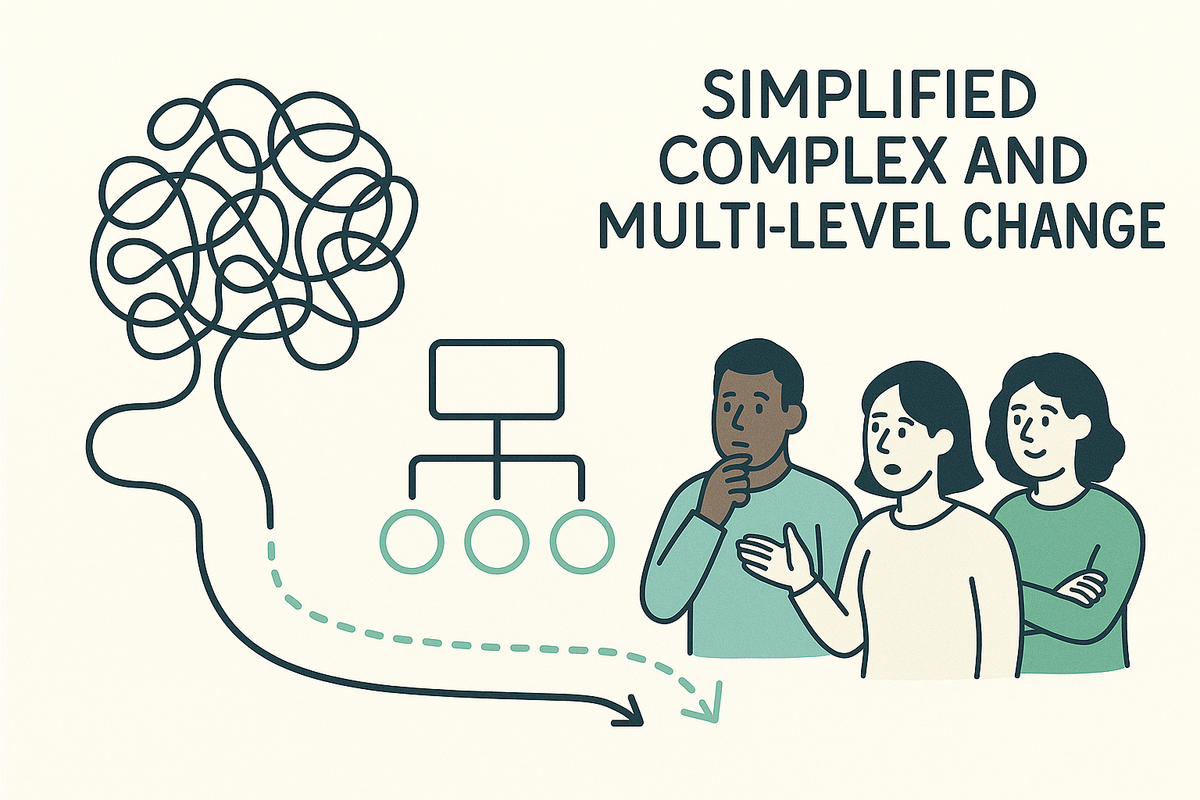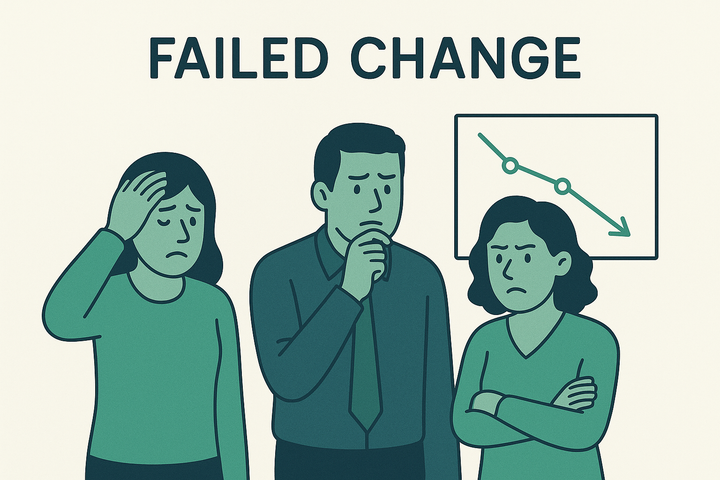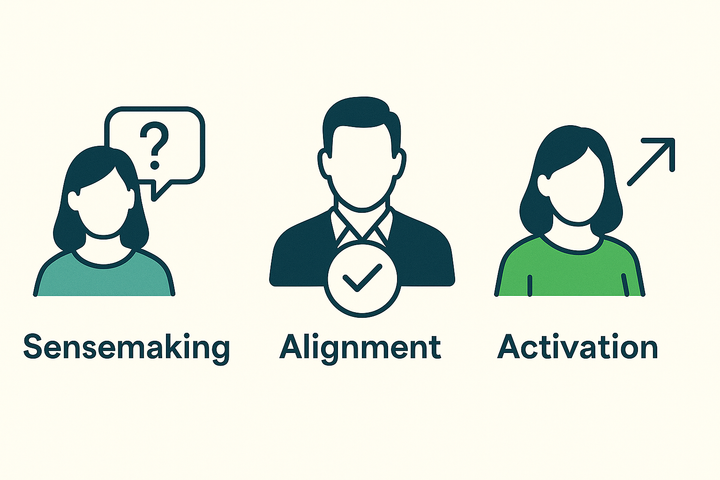Communicating Complex and Multi-Level Change
Change isn’t just one message anymore. It’s layered, messy and often overwhelming. Here’s how to map, sequence and communicate complex, multi-level change so people don’t just hear it — they act on it.

Change used to be a single, linear initiative. One programme. One transformation. One strategy shift.
Not anymore.
Today, most organisations are navigating layered, overlapping, cross-cutting change. A digital overhaul collides with a new operating model. A culture refresh overlaps with a restructuring. AI adoption cuts across everything. The result? Complexity. And often, chaos.
If you're a leader, communicator or change lead, the real challenge isn't just designing the change. It's explaining it. Sequencing it. Making it land — and making it stick.
This article is your practical guide to communicating complex, multi-level change in a way that actually works.
Why change comms falls apart under complexity
Let’s call out the obvious: most internal comms teams aren't resourced or structured for complexity. They're built for broadcast — not orchestration. So when complexity arrives, things fall apart:
- Messages overlap, contradict, or compete.
- Initiatives are launched without context or coordination.
- Leaders use different language for the same change.
- People get confused about what's happening, what's priority, and what they need to do.
- Managers are expected to cascade 17 things by Friday.
In the absence of clarity, people retreat. They disengage. Or they just wait to see what blows over.
And that means change — even the good stuff — stalls.
What makes a change "complex"?
Change becomes complex when it has:
- Multiple strands — e.g. strategy, culture, technology, structure
- Multiple layers — from board-level to frontline
- Multiple speeds — some fast, some slow
- Multiple impacts — from job redesign to mindset shift
- Multiple sponsors — often with different priorities
The problem? Each of those strands often has its own team, language, metrics and momentum.
What you need is a way to bring it together. Not to oversimplify — but to sense-make, sequence, and communicate in a way people can actually follow.
Start with three dimensions: Timeline. Hierarchy. Impact.
To make sense of complex change, you need to map it first.
Use this model:
1. Timeline
- What’s happening now, next, and later?
- Which changes are already live, and which are in development?
- Are there dependencies that affect when things can (or should) be communicated?
2. Hierarchy
- Which changes are enterprise-wide?
- Which are functional, team-specific or location-bound?
- Who is actually affected — and who isn’t?
3. Impact
- What’s the level of disruption?
- Does it affect behaviours, processes, systems or values?
- Will people need to unlearn, relearn or just be aware?
This is your change map.
Build it collaboratively — with change leads, HR, PMO, tech, and comms. Use it to:
- Prioritise messages
- Sequence storytelling
- Identify audience clusters
- Avoid overload
- Spot where silence is creating risk
Think pipeline, not plan
A change map shows you the territory. But to manage complexity in motion, you need a change pipeline.
A pipeline gives you:
- Visibility of what’s coming
- Control over pacing
- Early warning of pinch points
- A way to layer comms — not drop it all at once
You wouldn’t push five emails, three town halls and two intranet posts in the same week — but it happens all the time without a pipeline view.
Treat your comms like product releases. Use sprints. Create cycles. Align by week, month, or phase.
Match the message to the moment
One of the most damaging things in complex change is using the same tone for every update.
Treat everything like a crisis, and people switch off. Underplay something big, and they panic.
Calibrate.
Match tone, format and timing to:
- Scale of change
- Emotional weight
- Action required
- Clarity of direction
This is where The Four Types of Change and How to Communicate Them becomes essential. Not all change is created equal — and your message should reflect that.
Sequence beats cascade
In complex change, cascading doesn't work. It's too blunt. Too linear.
Instead, you need sequencing:
- Leaders first — aligned on message and tone
- Managers second — briefed, supported, and armed
- Staff third — messages tailored by impact and relevance
This is where Arming the Messenger comes in. Your managers need to be more than delivery channels. They need to be advocates — and that means time, context and support.
Use a narrative spine
In complexity, people crave coherence. So give them a narrative they can hold onto — even if the individual strands are messy.
A narrative spine links everything back to a core message:
- Where we are
- Where we’re going
- How we’ll get there
- What this means for you
Every update, briefing or leadership message should return to the spine. That’s how you build clarity in chaos.
Make space for sensemaking
People don’t just need information. They need time and space to process, discuss and challenge.
That’s why Creating Feedback Loops in Complex Change is non-negotiable.
In complex change, you must:
- Hear what’s being misunderstood
- Spot where messages are clashing
- Learn what’s landing and what’s missing
You can’t manage complexity top-down. You need listening posts, feedback loops and real-time adjustment.
Bring order without removing complexity
Your job isn’t to simplify the change. It’s to make it navigable.
Use metaphors that help people understand:
- Orchestration: different initiatives playing together under one conductor
- Traffic control: sequencing activity to avoid collision
- Energy grid: understanding capacity and managing load
These metaphors don’t dumb it down — they help people visualise their role, their bandwidth and their priorities.
Avoid strategy soup
One of the biggest risks in complex change is the emergence of what we call strategy soup:
- Five priorities
- Four programmes
- Three vision statements
- And zero clarity
Make it your mission to:
- Clarify the hierarchy of change initiatives
- Align naming conventions, visual identities and language
- Reduce internal competition for attention
When everything is priority one, nothing moves.
Plan for absorption
Don’t just track what’s being sent — track what’s being absorbed.
This means considering:
- Employee bandwidth
- Timing around other events or pressures
- Opportunity for dialogue, not just download
Change isn’t about noise. It’s about movement. And people don’t move if they’re overloaded.
Final thought
Complex change is no longer the exception — it’s the environment.
Your job as a communicator isn’t to simplify everything. It’s to:
- Understand the system
- Map the flow
- Build coherence
- Sequence messaging
- Tune the signal
Do that — and even in a whirlwind of transformation — your people will know where they stand, what matters, and what to do next.
Want help mapping your complex change and turning it into a coherent comms strategy?
Start with the Sound & Signal Review — our diagnostic that helps you cut through the chaos, prioritise messaging, and communicate with clarity across every level.
Or, if your programme is already live and struggling, the Rapid Action Accelerator will help you reset the story, realign your leaders and re-sequence the plan — fast.



